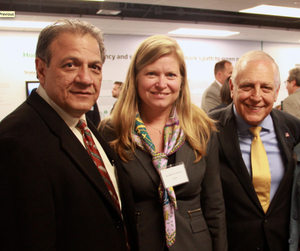New York City Climbs the Learning Curve on Renewable Natural Gas from Organic Waste
June 12, 2015
Matt Tomich
At Brooklyn’s Urban Future Lab last month, the clean energy NGO Energy Vision held a public panel on “The Power of Waste: Extracting the Greatest Value from NYC's Organics,” with New York City Department of Sanitation (DSNY) Commissioner Kathryn Garcia, and waste and gas industry leaders.
It was a deep dive into capturing methane and other biogases from organic wastes, including food and yard waste as well as wastewater and processing it into renewable natural gas (RNG) and compost.
Organic waste comprises 31 percent of New York City’s residential waste stream, and New York is the birthplace of the RNG industry: the first landfill facility to capture and use biogas was built at New York’s Fresh Kills landfill in 1980 and still operates today.
“It took emissions out of the air and produced pipeline quality natural gas,” said Bob Catell, chairman of the Advanced Energy Research and Technology Center at Stony Brook University and former head of National Grid U.S. Catell was instrumental in getting the Fresh Kills biogas facility built. “Renewable natural gas has all the benefits of other natural gas and it’s cleaner. But you don’t have to drill to find it, it comes from renewable resources. It can be used for fuel, co-generation, whatever you use natural gas for.”

Rocky DiRico, Deputy Commissioner, Support Services, DSNY, Kathryn Garcia, DSNY Commissioner, and Robert Catell, Chairman, AERTC at Stony Brook
That includes fueling trucks and heavy vehicles that can run on natural gas, some of which the DSNY has in its fleet. Fueling vehicles and offsetting diesel and gasoline consumption is the use of RNG that saves the most carbon emissions. In fact, when it’s made in anaerobic digesters and used as a transportation fuel, RNG can be net carbon-negative over its lifecycle, actually resulting in less greenhouse gas in the air than if it were never captured and used in the first place.
New York Mayor Bill de Blasio recently announced organic waste collection will be extended across the entire city by 2018. For now DSNY has a voluntary pilot program serving 100,000 residences in parts of Brooklyn and Queens, yielding between 20 and 40 tons on a typical day.
“We’re learning a lot,” Garcia said. “We need relatively clean material so our processers will accept it. We’re finding our material is woodier than we thought, we see plastic bags and diapers that aren’t supposed to be in there.” DSNY is experimenting with different methods to improve separation and achieve citywide participation.
Some of that waste is processed in anaerobic digesters at the Newtown Creek Wastewater Treatment Plant, near the border of Brooklyn and Queens. The facility’s biogas used to be flared. Now, source-separated organic waste is added to the wastewater in anaerobic digester tanks to boost production of biogas, which is refined into RNG. When fully operational and scaled up next year, Newtown Creek will have the capacity to process 15 percent of New York City’s residential organic waste a year. That would produce enough RNG to heat 5,000 homes or displace over 3 million gallons of diesel vehicle fuel.
“Newtown Creek is proof of concept that you can really do this,” said Don Chahbazpour, Director of Network Strategy for National Grid, who helped develop the Newtown Creek facility. “We have found a gas well in the middle of Brooklyn.”
Nearby, Long Island Compost in suburban Westbury, New York processes over 200,000 tons of organic waste a year—mostly yard waste—into finished soil and mulch. But it’s branching out, developing an AD facility that will take in food waste to produce RNG as well as compost. “One advantage of AD is extracting maximum value out of the food waste, said Charles Vigliotti, the company’s president and CEO. “We’re talking with a gas company about buying our gas, setting up our fueling station, and converting 20 of our trucks to natural gas.”
Like DSNY, LIC is also figuring out how to handle contamination in the waste stream, and nitrogen-rich digestate, “which is either really valuable or a real monster,” said Vigliotti. Since nitrogen is a hazard for Long Island Sound, LIC is cleaning nitrogen out of the digestate from 3,000 ppm down to 7 ppm. The extracted nitrogen will be used as a feedstock by its partner Scotts Miracle-Gro.
“The upcoming COP21 climate meeting in Paris needs to see demonstrated success with a carbon-negative strategy like RNG in a major city front and center,” said Joanna Underwood, president of Energy Vision, which researches and promotes low-carbon energy and transportation fuels and technologies. “New York has a stunning opportunity to show what can be done, and provide leadership for cities and countries around the world.”
Matt Tomich is vice president of Energy Vision.
You May Also Like


